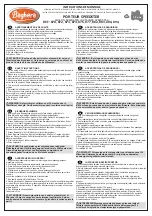
Slayer
•
37
Basic Tuning Adjustments
Brake Shoulder Screw Adjustment
The two shoulder bolts that are
used to secure the brake pads to
the transmission housing may
need to be adjusted periodically
as the brake material wears down.
They should be tightened so a
0.50mm (.020”) gap exists between the disk and the brake pad (on the
transmission side). Adjust in one of the following ways:
1.
Use a .50mm feeler gauge between the brake pad insert and brake disk.
2.
Push the outer brake pad firmly against the inner pad with your
finger, sandwiching the brake disk between the brake calipers.
Tighten the brake shoulder bolts until they just barely touch the
brake pads. Do not over tighten these fasteners or you could damage
the brake calipers. Loosen each of the shoulder bolts by 1 turn.
Brake Linkage Adjustment
When correctly adjusted, the brake linkage
spring should barely touch the rod guide
when the servo is in neutral position
(closed throttle). This will ensure no brake
drag during operation of the vehicle. The
brake adjustment knob can be threaded
away from the spring for less braking
power if desired. Do not adjust knob to
apply pressure against the spring while
the servo is in the neutral position.
This will induce brake drag and cause
undesirable handling.
The position of the z-bend from the
factory is in the middle position of the
servo horn. Changing this position will
affect the way the brake force is applied. The brake adjustment knob
will need to be readjusted if this position is changed.
Brake Pad Wear and Replacement
During normal use the brake pads should wear at a relatively slow rate.
However, if the brake pads wear down close to the metal pad holders,
they should be replaced. Any more wear than this could cause damage
to the brake parts and improper operation of the brake system.
0.5mm
gap
Front of Truck
Less Brake
Brake
Linkage
Spring








































